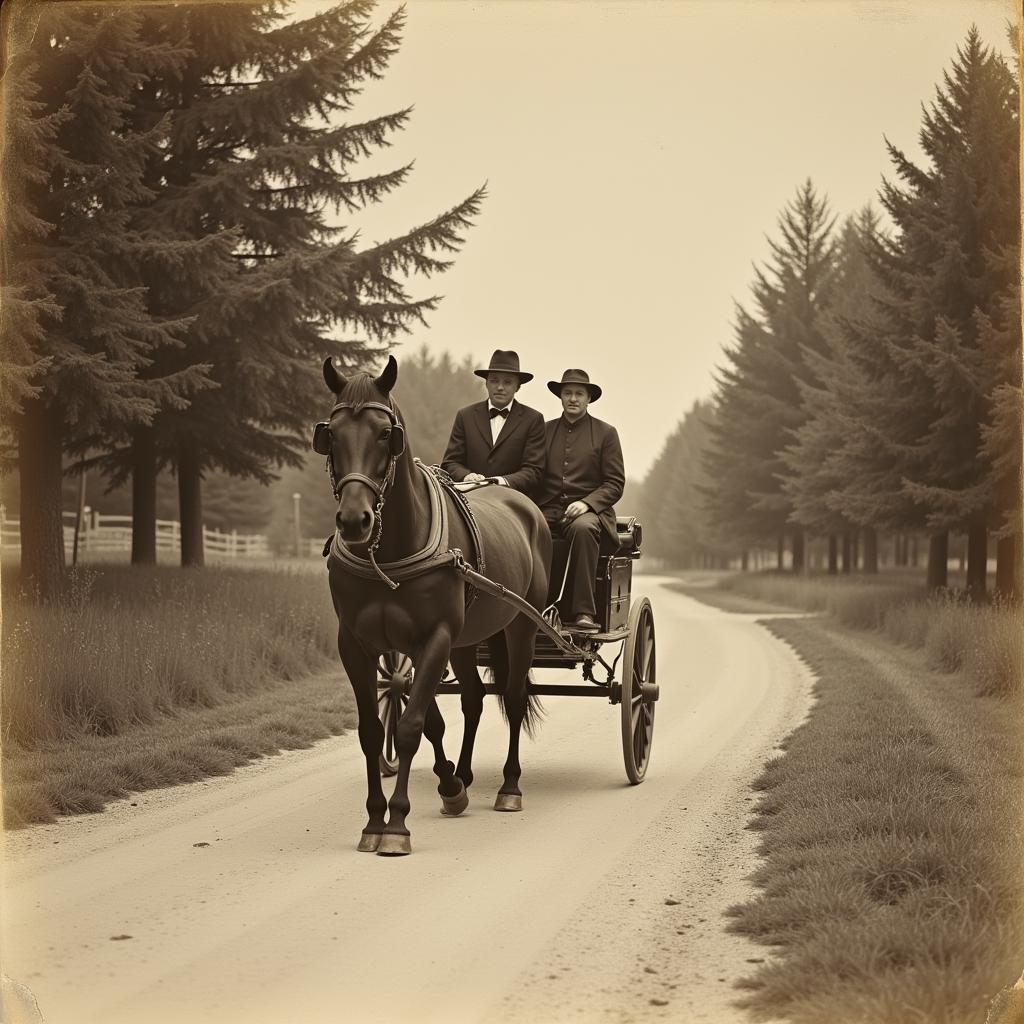Horse And Buggy Days evoke images of a simpler time, a slower pace, and a deep connection between humans and horses. This era, spanning primarily from the late 18th to the early 20th centuries, witnessed the horse-drawn buggy as the primary mode of transportation for many. Let’s delve into this fascinating period, exploring its history, impact, and lasting legacy.
The Rise of the Horse and Buggy
The horse and buggy era didn’t emerge overnight. It was the culmination of various technological advancements, starting with the invention of the wheel and the domestication of horses. Early carriages were crude and uncomfortable, but over time, innovations like sprung suspensions and pneumatic tires drastically improved the riding experience. The buggy, a lighter, more affordable carriage, became particularly popular, making personal transportation accessible to a wider population. This period truly revolutionized travel and social interactions, connecting communities in ways never before possible.
The Impact on Society
The prevalence of horse and buggy travel significantly impacted social life. Journeys that once took days could now be completed in hours, facilitating trade, communication, and personal visits. The rhythm of life was dictated by the horse, its speed, and its endurance. This slower pace fostered a sense of community and connection with nature, a stark contrast to the fast-paced world we live in today. Social gatherings and church visits became more frequent, strengthening community bonds.
 Horse and buggy on a rural road during the late 19th century
Horse and buggy on a rural road during the late 19th century
The Decline of Horse and Buggy Days
The advent of the automobile marked the beginning of the end for the horse and buggy. The automobile offered speed, convenience, and a perceived sense of modernity that the horse and buggy couldn’t match. As automobiles became more affordable and accessible, the horse and buggy gradually faded from everyday life, becoming relegated to leisure activities and historical reenactments. The transition, however, wasn’t instantaneous. Many rural communities continued to rely on horse-drawn transportation for years after the automobile’s introduction.
What Replaced the Horse and Buggy?
The automobile was the primary successor to the horse and buggy. Its internal combustion engine provided a more powerful and efficient means of transportation, revolutionizing travel and transforming the landscape. This shift marked a significant turning point in history, ushering in the age of motorized vehicles and paving the way for the complex transportation networks we have today.
The Legacy of Horse and Buggy Days
While the horse and buggy are no longer the primary mode of transportation, their legacy endures. We see remnants of this era in preserved historical districts, antique buggy collections, and popular cultural depictions. The horse and buggy days remind us of a simpler time, a time of closer connections to our communities and the natural world. This era continues to capture our imagination, offering a glimpse into a bygone era that shaped the world we live in today.
How are Horse and Buggies Used Today?
Today, horse-drawn buggies are primarily used for recreational purposes, such as leisurely rides, historical reenactments, and weddings. In some Amish communities, the horse and buggy remain an integral part of daily life, reflecting their commitment to traditional values and a slower pace of life. This continued use preserves the practical and cultural significance of the horse and buggy.
Conclusion
The horse and buggy days represent a pivotal period in history, shaping transportation, social interactions, and the very fabric of society. While this era has passed, its legacy continues to resonate, reminding us of the enduring bond between humans and animals, and the importance of appreciating a slower, more deliberate pace of life.
FAQ
- When were the horse and buggy days? Primarily the late 18th to the early 20th centuries.
- Why did the horse and buggy become popular? They were a more affordable and accessible form of personal transportation.
- What led to the decline of the horse and buggy? The invention and widespread adoption of the automobile.
- How are horse and buggies used today? Primarily for recreation, historical reenactments, and in some religious communities.
- What is the legacy of the horse and buggy days? A reminder of simpler times and closer community connections.
- How did horse and buggy days impact society? They facilitated trade, communication, and stronger community bonds.
- What were the advantages of the horse and buggy? They allowed for more convenient travel compared to walking or riding horseback.
Need assistance? Contact us at Phone Number: 0772127271, Email: [email protected] or visit us at QGM2+WX2, Vị Trung, Vị Thuỷ, Hậu Giang, Vietnam. We have a 24/7 customer service team.